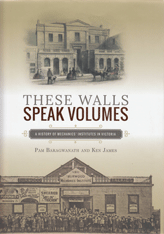These Walls Speak Volumes
A History of Mechanics' Institutes of Victoria
by Pam Baragwanath and Ken James
Reviewed for MIV by Alex Tyrrell
The Mechanics’ Institutes, writes Pam Baragwanath, have been written off as a story of failure. This splendid history, of which she and Ken James are the co-authors, points to a different conclusion. Drawing on many years of dedicated research, it provides meticulously compiled entries for almost 1000 Institutes, leaving no doubt as to the crucially important role that they have played in the life of Victoria. Although the intention of the early Institutes to provide science classes for artisans had a fitful existence, this book shows that the wider aspirations of the ‘useful knowledge’ movement were not forgotten. Institutes provided libraries; there were lectures, classes and debates; some had museums; and there were musical performances.
Among the interesting features of this history are many striking examples that demonstrate how the beliefs and practices of migrants can be adapted to suit the conditions of life in a new country. The ‘lofty ideals sometimes had to yield to demands for less cultured pastimes’, but throughout Victoria the Mechanics' Institute, housed as often as not in a simple wooden structure, became the hub of the community during the pioneering days, often serving as the only public building for miles around. It is hard to think of any get-together that did not take place there from court sessions, elections and religious meetings to weddings, balls, film shows, roller skating and billiards.
Weighing in at nearly three kilograms and 704 pages, an alphabetical list of short entries and appendices does not offer the promise of a good read, but, amidst the dates, listings of events and administrative information, there are fascinating glimpses of early Victorian social life. We can envisage, for example, how important the Casterton Institute was for its district when we read that during the 1880s there was ‘a seemingly endless procession of lecturers, dramatic and musical companies, acrobats, clowns and comics, novelty acts and religious fanatics’. When, as happened over and over again, communities experienced the loss of their cherished Institute by fire, we find them steadfastly setting to work on a replacement.
Admittedly, all was not always sweetness and light; human nature with all its foibles makes an appearance in these pages. The guardians of public decency at the Teesdale Institute burned books that they deemed to be immoral. The ‘disloyal, disgusting and filthy’ Bulletin was banned at Tatura. A major constitutional crisis erupted at Whittlesea when a formidable lady confronted the committee over the custody of the key and drove most of them to resign. The same Institute descended into ‘disorder’ on several occasions when the local Church of England clergyman and headmaster clashed in angry disagreement. Obviously there were problems at the Wehla Institute when the secretary was remanded for stealing books.
This is a beautifully produced volume, handsomely printed and copiously illustrated with photographs, many of them very old. It should serve, not only as a model for future publications about Institutes in other parts of the world, but also as an indispensible source for the social history of Australia.
MECHANICS' INSTITUTES OF VICTORIA INC.
PO BOX 1080, WINDSOR, VICTORIA 3181 AUSTRALIA
Reg No. A0038156G ABN 60 337 355 989
(c) 1998-2017, Mechanics Institutes of Victoria Inc. All rights reserved.

